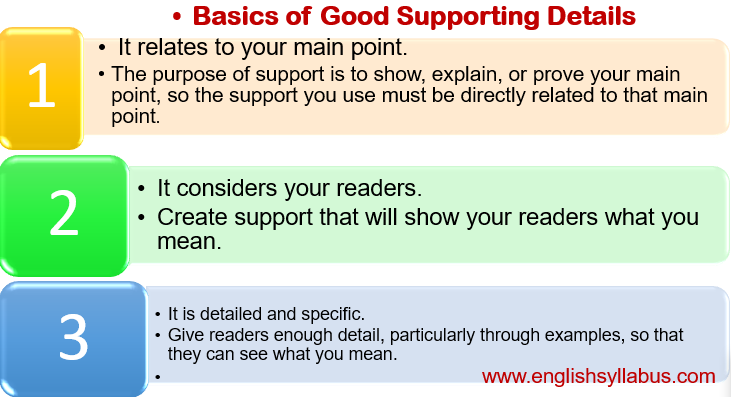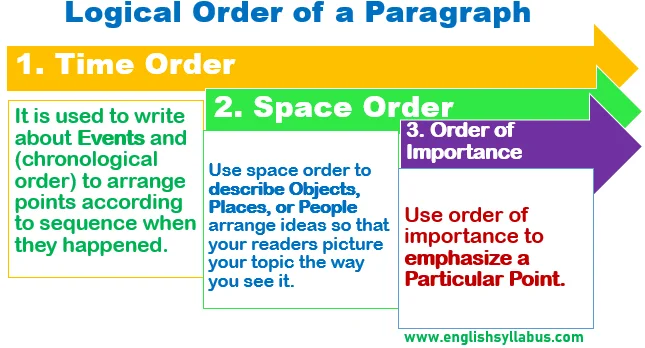Parts of Paragraph Structure
A paragraph is a group of connected sentences (a unit of writing) that focuses on a single topic or subject. A well-ordered paragraph is strategically arranged as a whole like a basic building block. So, a well-organized paragraph not only supports readers in following the argument but also assists an author to structure his ideas properly. For example, a paragraph can be found in almost any type of written material, including essay writing, articles, and stories. Its structure can vary depending on the purpose and style of paragraph writing, but most of them have at least three basic parts:
- Topic Sentence (Introduction)
- Supporting sentences (Details)
- Concluding Sentence (Closing)
- Topic sentence: The topic sentence is the controlling and main idea of the paragraph. It states the main point that the paragraph is trying to make and sets the tone for the rest of the paragraph. Most probably, the first sentence of the paragraph appears as the topic sentence.
- Supporting sentences (Supporting Details): The supporting sentences provide evidence and details. It supports the topic sentence because it contains key facts and points which explain, illustrate, or give examples of the main idea.
- Concluding sentence: The concluding sentence is the final sentence of the paragraph. It summarizes the main points of the paragraph and ties the paragraph together. It gives the readers reminder of the main point and to make an It gives the readers reminder of the main point and to make an observation. It may also suggest future implications or provide a transition to the next paragraph.

Sample Paragraph Structure
2. Analyze the following paragraph after Reading.
The abundance of locally grown, high-quality products at the farmer’s market is always impressive. The local farmer’s market was bustling with activity on Saturday morning. Customers browsed stalls filled with fresh produce, handmade crafts, and homemade baked goods. One booth caught my eye with its colorful array of heirloom tomatoes. I chatted with the friendly farmer, who told me about the sustainable practices they use on their farm. I left with a bag full of juicy tomatoes and a newfound appreciation for small-scale agriculture. Overall, the farmer’s market is a great place to support local businesses and find unique, high-quality products.
| Parts of Paragraph | Division of Paragraph Structure |
| Topic Sentence | The abundance of locally grown, high-quality products at the farmer’s market is always impressive. |
| Supporting Sentences | The local farmer’s market was bustling with activity on Saturday morning. Customers browsed stalls filled with fresh produce, handmade crafts, and homemade baked goods. One booth caught my eye with its colorful array of heirloom tomatoes. I chatted with the friendly farmer, who told me about the sustainable practices they use on their farm. I left with a bag full of juicy tomatoes and a newfound appreciation for small-scale agriculture. |
| Concluding Sentence | Overall, the farmer’s market is a great place to support local businesses and find unique, high-quality products. |
Unity and Coherence in Paragraph Layout
Paragraph Unity
Unity in paragraph structure refers to all the sentences and ideas in a paragraph fitting together to form a cohesive whole. And it indicates that all of our points are connected to our main ideas and are unified in support of it. A paragraph is said to have unity when all of the sentences in a paragraph relate to the main idea or topic sentence.
Paragraph Coherence
In Paragraph writing, coherence implies that all of our contributions come together to make a whole. Coherence in writing aids readers in understanding how one point leads to the next. So, Individual concepts should be linked together to form a coherent whole. The use of transition words (Conjunctions) is an effective technique to promote coherence. Coherence also means that the ideas in a paragraph flow logically from one sentence to the next. A paragraph is said to be coherent when the ideas in the paragraph are presented in a clear and logical order. So, the transitions between sentences help the reader understand how the ideas are connected.
Together, unity and coherence help to create a paragraph that is easy to understand and follow. When a paragraph has both unity and coherence, the reader can easily grasp the main idea of the paragraph and see how it is supported by the details and examples provided.

Use of Logical Orders in Paragraph Structure
Paragraph order refers to the pattern in which we communicate our ideas in writing. It matters to be aware of what comes first, what comes next, and what last in good paragraph order. And, there are three kinds of paragraph order: Time order, Space order, and order of importance.

In a paragraph, the structure can be organized in three different ways: Time order, Space order, and Order of importance.
1. Time Order (chronological sequence)
It is used to write about events and to organize points according to the order in which they occurred. So, arrange the paragraph details in the order in which they occurred. This is often used when describing events, processes, or stories. When we’re writing about events, it’s better to write in chronological sequence.
We can start with:
- From first to last/last to first.
- From the most recent to least recent / least recent to the most recent.
2. Space Order (location sequence)
To explain Objects, Places, or People, use spatial order to organize ideas. So that your readers can visualize your topic in the same manner you do. This refers to organizing the details in a paragraph based on their bodily location. This is often used when describing the structure of a place or the features of an object. So, when writing about a physical thing, location, or person’s looks, use space order. It is normally the best choice.
We can move from:
- Top to the bottom/bottom to the top
- Near to far/far to near
- Left to right/right to left
- Back to front/front to back
3. Order of Importance (relative sequence)
We use order of importance to emphasize a specific point or to organize facts according to their great significance, interest, or surprise value, use the order of importance. This refers to arranging the details in a paragraph based on their relative importance or significance. This is often used when writing persuasive texts or when trying to emphasize the most important points. But, the most crucial items are usually saved until last.
We can put it as:
- Least important to the most important
- Unwanted to the most wanted
- Most important to the least important
Examples of Paragraph Arrangement Orders
Example of Time order
For example, if you want to describe a trip to a museum, you might use time order to describe the events of a day: “First, we arrived at the museum and purchased tickets. Next, we walked through the exhibits on the first floor. After that, we stopped for lunch at the museum cafe. Finally, we ended our visit with a tour of the special exhibit on the second floor.”
Example of Space order
Alternatively, you might use space order to describe the layout of the museum: “The museum entrance was located at the front of the building, with the gift shop to the right and the cafe to the left. The first-floor exhibits were arranged in a loop, starting with ancient artifacts and ending with modern art. The special exhibit on the second floor was located at the back of the building, and featured interactive displays and multimedia presentations.”
Example of an order of Importance
Finally, you may use an order of importance to highlight the most interesting and valuable aspects of the museum: “The museum’s special exhibit was the highlight of our visit. Featuring interactive displays and multimedia presentations, it offered a unique and engaging experience. The first-floor exhibits were also impressive, with a wide variety of ancient artifacts and modern art. The cafe and gift shop was convenient amenities, but not as noteworthy as the exhibits.”

